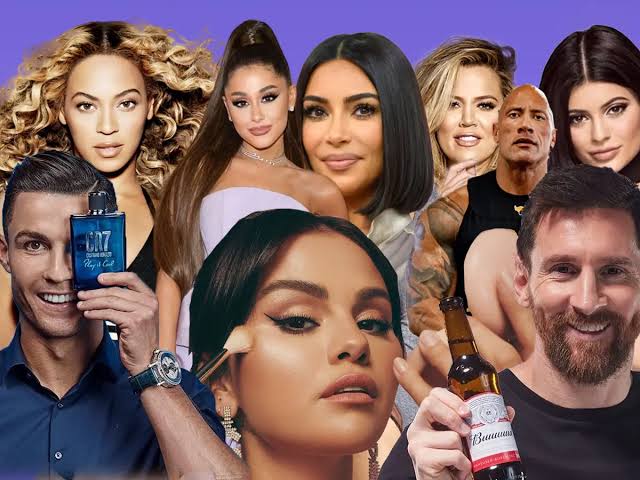IELTS Writing Part 2: Nowadays many teenagers have a celebrity who they follow as a role model. Some people think this is not a good idea, because celebrities often set a bad example. Do you agree or disagree?
In the hyper-connected world of today, celebrities and social media influencers have become an inseparable part of daily life for millions. With Instagram, YouTube, and TikTok offering a constant feed of curated images and videos, the younger generation is exposed to the lifestyles, habits, and values of these public figures at an unprecedented scale.
While some influencers use their platforms to inspire creativity, broaden horizons, and spread meaningful messages, many others promote shallow ideals, consumerism, and self-indulgence.
This essay argues that although a select few influencers are genuine role models worth emulating, the majority in the limelight today exert a harmful influence on impressionable minds by glamorizing materialism and unrealistic lifestyles.
A major issue with the way many influencers shape the aspirations of young people is their relentless display of material wealth. Luxury cars, designer clothes, expensive vacations — these are presented not as rare privileges but as everyday norms. This constant exhibition creates the illusion that success is measured solely by possessions, leading the so-called “blank generation” to splurge recklessly in an attempt to mirror these glamorous lives. Influencers post “unboxing” videos of costly gadgets, flaunt closets filled with high-end brands like Gucci and Chanel, and share vlogs of extravagant shopping sprees. Such portrayals subtly endorse a “spend now, think later” attitude, with young viewers sometimes draining their savings or going into debt to keep up with trends. A well-known YouTuber once casually revealed purchasing a $200,000 sports car purely “for content,” sparking similar impractical purchases among fans.
In conclusion, this incessant glorification of excess sows the seeds of a consumerist culture that values appearance over substance.
The damage does not end with materialism. Social media thrives on the illusion of perfection, and influencers are experts at curating it. Through edited photos, staged videos, and scripted interactions, they create a reality that is filtered, polished, and often far removed from the truth. The younger generation, unaware of the behind-the-scenes manipulation, may internalize the idea that happiness and self-worth are linked to flawless looks, luxury travel, or constant excitement.
This leads to a dangerous cycle of comparison, dissatisfaction, and low self-esteem. For instance, a famous fashion influencer was exposed for renting expensive outfits and props for photoshoots to maintain a false image of affluence. Even after the truth came out, the damage was done — her followers had already spent months comparing their lives to an illusion.
Therefore, the deceptive “highlight reel” lifestyle promoted by many influencers distorts reality and undermines mental well-being.
Yet, it would be unfair to paint all influencers with the same brush. There are those who harness their visibility to inspire and educate. Travel vloggers who explore new countries and immerse themselves in diverse cultures provide more than entertainment; they promote tolerance, curiosity, and global understanding.
By documenting not just tourist attractions but also local customs, food, and challenges, they foster empathy and appreciation for cultural differences. Figures like Drew Binsky, who has visited nearly every country on Earth, use their platforms to tell authentic stories of ordinary people, breaking stereotypes and encouraging meaningful travel.
Similarly, educational influencers can transform social media into a tool for growth. Science communicators, historians, and motivational speakers reach millions with content that informs and uplifts. Jay Shetty, for example, has built a platform centered on mindfulness, resilience, and purposeful living, influencing audiences to cultivate inner peace rather than chase fleeting pleasures.
Environmental activists such as Leonardo DiCaprio use their fame to spotlight climate change and fund conservation projects, proving that influence, when wielded responsibly, can become a force for global good.
Pakistani mountaineer Samina Baig not only inspires young women to break barriers in sports but also raises awareness about climate issues in the Himalayas. These figures act as beacons in the digital fog — showing that fame can serve humanity rather than personal vanity.
Unfortunately, such positive influencers are outnumbered by those who cater to viral trends and instant gratification. The attention economy rewards controversy, extravagance, and sensationalism far more than depth or authenticity. The result is an online environment where the loudest, flashiest personalities drown out the quieter voices of wisdom. This reality demands that young audiences learn to separate the wheat from the chaff — to distinguish between those who enrich their lives and those who merely entertain at the cost of their values.
Nevertheless, the challenge is not the existence of influencers, but the lack of discernment in choosing whom to follow.
In the final analysis, the sway that influencers hold over the younger generation is a double-edged sword — capable of shaping lives for the better or for the worse. On one hand, there are paragons of virtue who use their reach to sow the seeds of inspiration, cultural awareness, and personal growth; on the other, there are wolves in sheep’s clothing who peddle vanity, superficiality, and ephemeral fame.
The blank generation must learn that true worth is not measured by the labels in one’s wardrobe or the horsepower in one’s garage, but by the depth of one’s character and the positive mark one leaves on the world. As the saying goes, “All that glitters is not gold,” and in the age of influencers, this is truer than ever. A life well-lived is not the one most liked, but the one most meaningful — a truth that, if embraced, could turn the tide of modern influence from hollow spectacle to lasting legacy.
📍 English Language Educator | Blogger & Content Strategist | 7+ Years in Educational Blogging
Nosheen Bashir is a dedicated English teacher and experienced blogger with over seven years of expertise in content creation and educational writing. Passionate about language, literature, and effective communication, she combines her teaching experience with blogging skills to create insightful, research-backed content that helps learners and educators alike.
🔹 Expertise & Achievements:
✔ English Language Education: A skilled educator with years of experience in teaching English grammar, literature, and communication skills to students of varying levels.
✔ Educational Blogging: Running a successful blog for 7+ years, delivering well-structured, engaging content on language learning, writing techniques, and academic success.
✔ SEO & Content Strategy: Specializes in creating high-ranking, authoritative articles that follow Google’s EEAT principles, ensuring content that is both informative and search-friendly.
✔ Student-Centric Approach: Committed to making English easier, engaging, and accessible, helping readers and students improve their language proficiency.
🚀 With a passion for teaching and writing, Nosheen Bashir is dedicated to crafting educational content that empowers students, teachers, and language enthusiasts worldwide.










